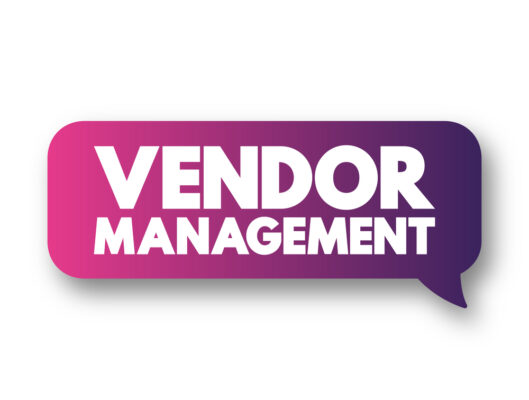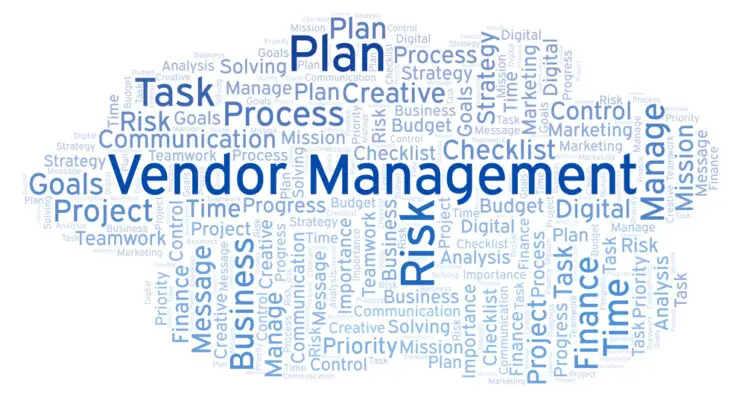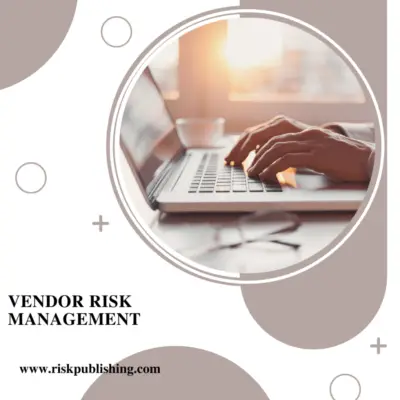Software vendor management involves managing relationships with the software vendors that provide the tools and services your business relies on. Examples of best practices for software vendor management:
Establish Clear Goals and Expectations: Before entering into a relationship with a software vendor, it’s important to understand what you need from them. This includes the specific services or products you require, the level of support you expect, and any other specific requirements your business has.
Regular Communication: Regular communication with your software vendors is crucial. This can help you stay up-to-date with any changes or updates to their services, and it can also help you address any issues or concerns as they arise.
Performance Monitoring: monitoring can help you ensure they meet your expectations and deliver your desired services. If a vendor’s performance is not up to par, it may be time to consider finding a new vendor.
Contract Review: Reviews can help you ensure that the contract terms are still suitable for your business, and they can also help you identify any areas where you may be able to negotiate better terms.
Risk Management: Managing risk is a key aspect of software vendor management. This includes identifying potential risks associated with each vendor, such as a vendor going out of business or a security breach, and taking steps to mitigate these risks.
Vendor Evaluation: Evaluation can help you identify vendors that are not meeting your expectations and may need replacing.
Build Strong Relationships: Building strong relationships with your vendors can lead to better service, favorable terms, and a more successful partnership. This includes treating your vendors as partners rather than just suppliers and working to build a relationship based on mutual respect and trust.
In today’s technology-driven world, software plays a crucial role in the success of any business. As organizations increasingly rely on software to manage their operations, the importance of effective vendor management cannot be overstated.
Software vendors provide critical services and products that enable businesses to achieve their objectives. However, managing multiple vendors can be complex and challenging, requiring a well-defined strategy that balances cost, quality, and risk.
Software vendor management refers to overseeing relationships with software vendors to ensure they meet an organization’s needs effectively and efficiently.
Effective vendor management involves establishing clear expectations and objectives for vendors, conducting thorough evaluations of potential vendors before entering into contracts, monitoring vendor performance regularly, fostering collaboration and communication between stakeholders and vendors, and continuously improving processes to optimize results.
This article will explore best practices in software vendor management that can help organizations improve their operational efficiency while reducing costs and risks associated with outsourcing software development or maintenance activities.

Establish Clear Expectations and Objectives
Implementing software vendor management best practices necessitates establishing clear expectations and objectives, which serve as a foundation for successful collaboration between the organization and its software vendors.
Clear expectations and objectives allow both parties to understand what is expected from each other and what outcomes are desired. This helps avoid misunderstandings, miscommunications, and delays in software development or maintenance projects.
Organizations must define their requirements in detail to establish clear expectations and objectives, including functional and non-functional aspects such as performance standards, data security requirements, compliance regulations, scalability needs, etc.
They must also communicate these requirements effectively to their software vendors through requests for proposals (RFPs), service level agreements (SLAs), or contracts. In addition to defining technical requirements, organizations should also set expectations for communication protocols, project timelines, reporting mechanisms, issue escalation procedures, and change management processes.
Finally, organizations must involve all stakeholders in establishing clear expectations and objectives. This includes IT professionals and business users using the software applications developed by the vendors.
By involving all stakeholders from the beginning of the process ensures that everyone has a voice in shaping the project’s direction and outcome. It also helps build buy-in among team members who may resist changes or new technology solutions implemented within their organization.
Thus creating an environment that fosters innovation while ensuring accountability toward meeting goals and delivering tangible results at every project lifecycle stage.
Conduct Thorough Vendor Evaluations
Conducting comprehensive evaluations of potential partners is crucial to ensuring long-term success in establishing mutually beneficial business relationships.
One way to achieve this is by creating a thorough vendor evaluation process that involves identifying the key criteria for selection and evaluating each vendor based on these factors. The criteria should be tailored to specific needs and objectives, such as pricing, quality of service, delivery timeframes, or compliance requirements.
To conduct an effective evaluation, it is important to involve all relevant stakeholders in the process. This may include representatives from different departments or external consultants with expertise in the industry or technology area of interest.
Each stakeholder should contribute their perspective and expertise to ensure that all aspects of the evaluation are covered. Additionally, it is essential to establish clear communication channels between the vendor and stakeholders throughout the evaluation process.
A useful tool for conducting a comprehensive vendor evaluation is a decision matrix table. This table can help stakeholders assess vendors against different criteria and prioritize them based on their strengths and weaknesses.
The table can be divided into two columns: one for vendor names and another for key criteria such as product features, price points, customer service ratings, etc. A third row can be added with weighted scores assigned to each criterion by importance level (e.g., 1-5).
These scores can then be multiplied by each vendor’s rating in that category to calculate an overall score for each option. This approach allows organizations to make informed decisions about which vendors best align with their needs while minimizing risk and maximizing benefits over time without relying solely on subjective opinions or assumptions alone.
Monitor Vendor Performance
When managing vendors, it is critical to monitor their performance to ensure that they meet the agreed-upon standards and expectations.
Establishing metrics and benchmarks is essential to achieve this as it provides a baseline for evaluating progress and assessing results.
Regularly reviewing progress against these metrics enables organizations to identify areas of improvement or potential issues early on, allowing them to address concerns promptly before they escalate into more significant problems.

Establish metrics and benchmarks.
Establishing metrics and benchmarks for software vendor management involves the creation of measurable standards that can help an organization evaluate vendor performance and identify areas for improvement.
Metrics are quantitative measures used to assess vendor performance against predetermined goals, while benchmarks refer to industry best practices or standards that organizations can use to compare.
Establishing these metrics and benchmarks allows organizations to set expectations, track progress, and make informed decisions about their software vendors. To establish effective metrics and benchmarks for software vendor management, organizations should consider the following:
- Identify key performance indicators (KPIs) that align with strategic objectives.
- Define acceptable levels of performance for each KPI.
- Determine how data will be collected and analyzed to measure vendor performance.
- Continuously monitor metrics to identify trends or areas for improvement.
- Regularly review and update benchmarks based on changes in industry standards or organizational needs.
This approach promotes transparency, accountability, and continuous improvement in vendor management practices.
Regularly review progress and results.
Regularly reviewing progress and results are crucial for organizations to ensure that their metrics and benchmarks effectively measure vendor performance and drive continuous improvement in their supplier relationships.
By conducting regular reviews, organizations can identify gaps or improvement areas in their vendor management processes and take corrective action as necessary. This allows them to stay on top of any issues before they become major problems, reducing the risk of project delays, cost overruns, or other negative impacts on business operations.
In addition to identifying areas for improvement, regular reviews also allow organizations to recognize vendors who are performing well and contributing positively to the organization’s success.
This can help build stronger relationships between suppliers and buyers, leading to more collaboration, better communication, and ultimately higher quality products or services.
Regularly reviewing progress and results, organizations can optimize vendor management processes and achieve greater value from supplier relationships.
Address issues and concerns promptly.
Promptly addressing issues and concerns that arise in vendor relationships is essential for maintaining the smooth functioning of business operations and ensuring high-quality products or services.
When issues are left unaddressed can escalate into bigger problems that may result in delays, added costs, or even damage a company’s reputation. Therefore, it is crucial to have clear communication channels with vendors and establish a system for promptly reporting and resolving any issues.
To address issues and concerns promptly in vendor management, consider the following best practices:
- Set expectations: Communicate your expectations to vendors from the outset of the relationship. This includes establishing timelines for delivery, quality standards, and protocols for reporting issues.
- Collaborate: Work with vendors to identify the root cause of any issue or concern. This approach helps foster trust between parties and ensures a more effective resolution.
- Follow up: Once an issue has been resolved, follow up with the vendor to ensure it does not recur. This step is critical for preventing similar problems in future projects or purchases.
Foster Collaboration and Communication
Effective software vendor management requires fostering collaboration and communication with vendors. This involves encouraging open and honest communication, building strong relationships, and promoting teamwork toward shared goals.
By adopting these best practices, organizations can enhance their ability to work effectively with software vendors and achieve successful project outcomes.
Encourage open and honest communication.
Facilitating transparent communication channels is crucial in promoting a culture of honesty and openness among software vendors. Open and honest communication allows for identifying and resolving issues that may arise during the vendor management process.
It also encourages feedback, which can improve performance and establish stronger relationships between vendors and clients.
Encouraging open and honest communication can be achieved through various means, such as regular meetings, surveys, or electronic forums. These platforms allow both parties to share their thoughts on matters affecting the vendor-client relationship.
Additionally, it is essential to create an environment where vendors feel comfortable raising any concerns without fear of negative consequences. By doing so, organizations can foster trust with their vendors while creating accountability within their vendor management program.
Build strong relationships with vendors.
Establishing strong relationships with vendors is crucial to ensure a successful long-term partnership and achieve mutual goals. Building such relationships requires both parties to foster open communication, respect, trust, and transparency.
Organizations should view their software vendors as valuable partners in their business operations and treat them accordingly. This means involving them in the decision-making process regarding software procurement, implementation, customization, and maintenance.
Organizations should strive for transparency throughout the partnership to build strong relationships with vendors. Being transparent about budgets, timelines, expectations, and issues encountered during software deployment or usage can help foster trust between both parties.
Regular check-ins or status updates can also help keep lines of communication open while allowing both parties to stay informed of progress made on projects or initiatives.
Establishing a culture of collaboration where feedback is welcomed from all sides will lead to more effective problem-solving and ultimately improve the overall success of the vendor-client relationship.
Promote teamwork and shared goals.
Collaborative efforts and shared objectives among team members are pivotal to achieving desirable outcomes in business partnerships.
In software vendor management, promoting teamwork and shared goals between a company and its vendors can lead to better quality products, improved communication, and more efficient delivery of services.
Here are three ways companies can promote teamwork and shared goals with their software vendors:
- Clearly define project scope: By outlining the scope of work at the beginning of a project, both parties clearly understand what needs to be accomplished. This helps ensure that everyone is on the same page from the start.
- Establish open lines of communication: Regular communication is key to building strong relationships with vendors. Companies should establish regular check-ins with their vendors to discuss progress, address concerns or issues that may arise, and keep each other informed throughout the project lifecycle.
- Focus on mutual success: Instead of treating your vendor as just another supplier or contractor, view them as an extension of your team working towards common objectives. Providing incentives for meeting or exceeding performance targets will encourage both parties to work cooperatively towards mutual success.
Continuously Improve and Adapt
To promote continuous improvement and adaptation in software vendor management, it is important to regularly assess the effectiveness of current strategies and identify areas for enhancement.
One way to do this is by conducting periodic reviews that evaluate the performance of vendors against key metrics such as cost-effectiveness, quality of service, and responsiveness. These reviews can provide valuable insights into where improvements can be made and help establish benchmarks for measuring progress over time.
Another effective strategy for promoting continuous improvement is ongoing collaboration and vendor communication. Regular check-ins can help ensure that both parties are aligned on goals and expectations while also providing opportunities to discuss challenges or concerns that may arise.
In addition, soliciting vendor feedback on improving processes or procedures can lead to new ideas or approaches that benefit both parties.
Finally, remaining flexible and open-minded when adapting vendor management strategies is important. As technology continues to evolve rapidly, businesses must be willing to embrace change to stay competitive.
This may mean exploring new tools or platforms for managing vendors, adopting agile methodologies for project management, or experimenting with different outsourcing models.
| Advantages | Disadvantages |
|---|---|
| Encourages innovation | Requires investment in time/effort |
| Improves competitiveness | May require changes in organizational culture |
| Increases efficiency | Could create additional dependencies on vendors |
Frequently Asked Questions
How can I negotiate better pricing with software vendors?
To negotiate better pricing with software vendors, it is important to research the market rates and competitors’ prices. Establishing a long-term relationship with the vendor and highlighting your organization’s potential for future business can also lead to favorable pricing negotiations.
What are some common pitfalls to avoid when managing software vendors?
Common pitfalls to avoid when managing software vendors include failing to establish clear expectations, neglecting to monitor vendor performance, not maintaining open communication channels, and overlooking contract terms and renewal dates.
How do I handle a vendor that consistently underperforms or misses deadlines?
When a vendor consistently underperforms or misses deadlines, it is important to establish clear expectations and communicate them effectively. Consider renegotiating the contract or terminating the relationship if necessary to ensure project success.
What measures can I take to ensure that my company’s data remains secure when working with third-party software vendors?
Companies should implement strict contractual agreements and conduct thorough background checks on the vendor’s security practices to ensure data security when working with third-party software vendors. Regular monitoring and audits of vendor compliance can also help mitigate risks.
How can I effectively manage multiple software vendors at once?
Effective management of multiple software vendors involves creating a standardized vendor selection process, establishing clear communication channels with each vendor, monitoring performance metrics, and regularly reviewing contracts to ensure compliance with agreed-upon terms.

Conclusion
Effective software vendor management ensures successful collaborations between companies and their vendors. This article has highlighted several best practices that can help organizations establish clear expectations and objectives, conduct thorough evaluations of potential vendors, monitor performance, foster collaboration, and communication, and continuously improve and adapt.
Conducting thorough evaluations of potential vendors enables organizations to select the most suitable partner for their needs.
Monitoring vendor performance allows companies to identify any issues early on so that they can be addressed before they significantly impact project outcomes.
Fostered collaboration and communication facilitate smooth working relationships between companies and vendors by creating an environment where both parties can work together towards shared goals.
Finally, continuous improvement and adaptation enable companies to stay abreast of changing market trends while ensuring continued success in their vendor partnerships.
In conclusion, effective software vendor management is essential for successful collaborations between companies and their partners by implementing best practices such as establishing clear expectations.
Fostering collaboration and communication and continuously improving processes over time, organizations can build strong partnerships with their vendors that deliver positive outcomes for all involved parties.

Chris Ekai is a Risk Management expert with over 10 years of experience in the field. He has a Master’s(MSc) degree in Risk Management from University of Portsmouth and is a CPA and Finance professional. He currently works as a Content Manager at Risk Publishing, writing about Enterprise Risk Management, Business Continuity Management and Project Management.


